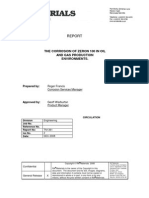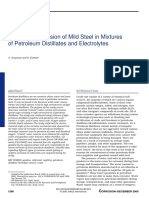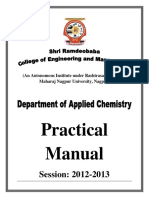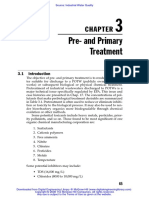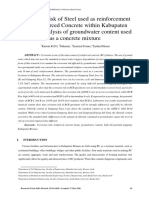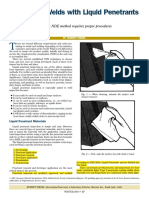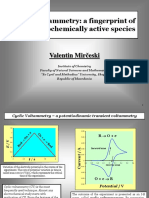Mitsubishi Diesel Engine Technical Information: Quality of Water Used As Engine Coolant
Mitsubishi Diesel Engine Technical Information: Quality of Water Used As Engine Coolant
Uploaded by
Moniru islamCopyright:
Available Formats
Mitsubishi Diesel Engine Technical Information: Quality of Water Used As Engine Coolant
Mitsubishi Diesel Engine Technical Information: Quality of Water Used As Engine Coolant
Uploaded by
Moniru islamOriginal Description:
Original Title
Copyright
Available Formats
Share this document
Did you find this document useful?
Is this content inappropriate?
Copyright:
Available Formats
Mitsubishi Diesel Engine Technical Information: Quality of Water Used As Engine Coolant
Mitsubishi Diesel Engine Technical Information: Quality of Water Used As Engine Coolant
Uploaded by
Moniru islamCopyright:
Available Formats
ITEM NO.
T54-0040-E (1/3)
MITSUBISHI DIESEL ENGINE
TECHNICAL INFORMATION DATE December, 1998
Quality of water used as engine coolant
1. The water in service coolant in diesel engine may appear, under visual observation, normal but such
appearance is no insurance that it will not foul up the cooling system. This is because water can contain
may substances, which are not visible but are harmful to the cooling circuit of the engine. Here lies the
reason why the harmful chemical properties and substances need to be identified and their limits of
tolerance be specified.
2. Coolant specifications are tabulated in Table 1.
3. Undesirable coolant quality factors and their effects are shown in Table 2.
4. The specifications (Table 1) are not different in substance from the LESR 3003 Standard-1985.
First Edition : Dec.1998 Engine Engineering Department
Large Engine Design Section
Revision
Approved by Checked by Drawn by
MITSUBISHI HEAVY INDUSTRIES, LTD.
GENERAL MACHINERY & SPECIAL VEHICLE HEADQUATERS
ITEM NO. T54-0040-E (2/3)
Table 1 Coolant Specifications
Main malign effect
Item Chemical Unit Recommended
symbol limit Corrosion Scale
and rust formation
pH (25°C) — — 6.5 to 8.5 ⃝ ⃝
Electrical conductivity — µ /cm < 400 ⃝ ⃝
(25°C)
Total hardness CaCO3 PPM < 100 — ⃝
M alkalinity CaCO3 PPM < 150 — ⃝
Chlorine ion Cl- PPM < 100 ⃝ —
2-
Sulfuric acid ion SO 4 PPM < 100 ⃝ —
Total iron Fe PPM < 1.0 — ⃝
Silica SiO2 PPM < 50 — ⃝
Residue from evaporation — PPM < 400 — ⃝
MITSUBISHI HEAVY INDUSTRIES, LTD.
GENERAL MACHINERY & SPECIAL VEHICLE HEADQUATERS
ITEM NO. T54-0040-E (3/3)
Table 2 Undesirable Coolant Quality Factors and Their Effects
Main malign effect
No. Item Symbol Unit Explanatory note Corrosion Scale
and rust formation
The pH scale (from 0 to 14) refers to
the concentration of hydrogen ions in
aqueous solutions. The solution is
1 pH (25°C) — — neutral if its pH is 7. The pH of 7 is ⃝ ⃝
dividing point between acidic
(corrosive to metals) and basic (scale
forming) property. In pure water, the
pH is 6 to 8.
High conductivity of solution means
Electrical that it contains large amounts of
2 conductivity — µ /cm electrolytic ions and undissolved solid, ⃝ ⃝
(25°C) and that it tends to attack metals and
also to promote scale formation.
Amounts of Ca and Mg ions in the
3 Total hardness CaCO3 PPM solution are expressed in PPM as — ⃝
equivalents of calcium carbonate
(CaCO3). Hard water produces scale.
The alkali contents (hydroxides,
carbonates and bicarbonates) are repre-
4 M alkalinity CaCO3 PPM sented by this term. Their amounts are — ⃝
expressed in PPM as CaCO3. Scale
formation is often caused by high M
alkalinity.
A high Cl concentration makes the
- solution very corrosive. For example,
5 Chlorine ion Cl PPM tap water in Japan has chlorine in an ⃝ —
amount of 10 to 40 PPM.
A high SO 2-
4 concentration attacks
copper and copper alloys. If the
6 Sulfuric acid SO 4
2-
PPM solution contains Ca, SO2 reacts with ⃝ —
ion
Ca2+ to form CaSO4, a substance that
readily gives rise to scale.
Fe in the solution in excess of 3.0 PPM
7 Total iron Fe PPM settles out and turns to coloring deposit. — ⃝
A high Fe concentration contributes to
scale development.
Silica combines with Ca and Mg to
8 Silica SiO2 PPM produce very hard scale. Water — ⃝
moderately hard does not present this
problem.
Undissolved solids, contributory to
conductivity of the solution as stated
Residue from above, remain as solid residue when the
9 — PPM solution is evaporated. The higher this — ⃝
evaporation PPM value, the stronger is the scale
forming tendency (and also the corro-
siveness) of the solution.
MITSUBISHI HEAVY INDUSTRIES, LTD.
GENERAL MACHINERY & SPECIAL VEHICLE HEADQUATERS
You might also like
- Water Pre - Treatment Process (Water Packaging)No ratings yetWater Pre - Treatment Process (Water Packaging)6 pages
- Notes - Unit 1 - Water Technology (2020)No ratings yetNotes - Unit 1 - Water Technology (2020)28 pages
- Properties and Manufacture of Ammonium Perchlorate: September 202050% (2)Properties and Manufacture of Ammonium Perchlorate: September 202011 pages
- Aspects On Chemistry in French Nuclear Power Plants: WK, Qwhuqdwlrqdo&Rqihuhqfhrqwkh3Urshuwlhvri:Dwhudqg6Whdplq./RwrNo ratings yetAspects On Chemistry in French Nuclear Power Plants: WK, Qwhuqdwlrqdo&Rqihuhqfhrqwkh3Urshuwlhvri:Dwhudqg6Whdplq./Rwr10 pages
- Trivalent Chromium Solutions For Applying Chemical Conversion CoatingsNo ratings yetTrivalent Chromium Solutions For Applying Chemical Conversion Coatings6 pages
- Research Rourbaix Diagrams For Copper in 5 RN Chloride SolutionNo ratings yetResearch Rourbaix Diagrams For Copper in 5 RN Chloride Solution54 pages
- Determination of The Amine Value: Mettler Toledo Application M242No ratings yetDetermination of The Amine Value: Mettler Toledo Application M2424 pages
- Annexure 3 Effluent Handling 3.1 Pollution Control FacilitiesNo ratings yetAnnexure 3 Effluent Handling 3.1 Pollution Control Facilities6 pages
- Boilers Water Treatment: Chemist / Mustafa Ateia MustafaNo ratings yetBoilers Water Treatment: Chemist / Mustafa Ateia Mustafa38 pages
- Sop Prod-Chm-750-01 (R o Softener Startup)No ratings yetSop Prod-Chm-750-01 (R o Softener Startup)19 pages
- A Study of Corrosion of Mild Steel in Mixtures of Petroleum Distillates and ElectrolytesNo ratings yetA Study of Corrosion of Mild Steel in Mixtures of Petroleum Distillates and Electrolytes6 pages
- 04 Sec. 3 Sewage Characteristics and Effluent Discharge Requirements PDFNo ratings yet04 Sec. 3 Sewage Characteristics and Effluent Discharge Requirements PDF8 pages
- Decomposition Characteristics of Humic Acid in Boiler Make-Up Water Inpower PlantsNo ratings yetDecomposition Characteristics of Humic Acid in Boiler Make-Up Water Inpower Plants6 pages
- Oil Analysis for Effective Transformer ManagementNo ratings yetOil Analysis for Effective Transformer Management26 pages
- 2015corrosion Inhibitor Selection Guideeversion PDF0% (1)2015corrosion Inhibitor Selection Guideeversion PDF4 pages
- Influence of Rolling Chemicals On Temper Rolling Process and Anti-Rust Performance of Cold Rolled SteelsNo ratings yetInfluence of Rolling Chemicals On Temper Rolling Process and Anti-Rust Performance of Cold Rolled Steels7 pages
- B-Doped Cryptomelane For BKYST-2023 - 2theta - Lamle's VersionNo ratings yetB-Doped Cryptomelane For BKYST-2023 - 2theta - Lamle's Version5 pages
- Commercial Experience in The Operation of Ards Units in Kuwait National Petroleum Company at Mina Al-Ahmadi RefineryNo ratings yetCommercial Experience in The Operation of Ards Units in Kuwait National Petroleum Company at Mina Al-Ahmadi Refinery15 pages
- O.J Suarez, J.J Olaya, M.F Suarez, S.E. RodilNo ratings yetO.J Suarez, J.J Olaya, M.F Suarez, S.E. Rodil6 pages
- Analytical Methods Hexavalent Chromium Plating SolutionsNo ratings yetAnalytical Methods Hexavalent Chromium Plating Solutions11 pages
- Applied Chemistry Practical Manual Session 12-13 PDF67% (3)Applied Chemistry Practical Manual Session 12-13 PDF62 pages
- (Third Revision: Methods For Chemical Analysis of SteelsNo ratings yet(Third Revision: Methods For Chemical Analysis of Steels6 pages
- Copolymer SJ-1 As A Fluid Loss Additive For Drilling Fluid With High Content of Salt and CalciumNo ratings yetCopolymer SJ-1 As A Fluid Loss Additive For Drilling Fluid With High Content of Salt and Calcium23 pages
- Pre-And Primary Treatment: Technical 6X9 /industrial Water Quality/Eckenfelder /866-1/chapter 3No ratings yetPre-And Primary Treatment: Technical 6X9 /industrial Water Quality/Eckenfelder /866-1/chapter 372 pages
- Electrochemical Behavior of C6.9 Mild Steel CorrosionNo ratings yetElectrochemical Behavior of C6.9 Mild Steel Corrosion18 pages
- Novel Ionic Liquid Compound Act As Sweet Corrosion Inhibitors For X-65 Carbon Tubing Steel: Experimental and Theoretical StudiesNo ratings yetNovel Ionic Liquid Compound Act As Sweet Corrosion Inhibitors For X-65 Carbon Tubing Steel: Experimental and Theoretical Studies19 pages
- Precipitation of Zirconium and Molybdenum in Simulated High-Level Liquid Waste Concentration and Denitration ProcessNo ratings yetPrecipitation of Zirconium and Molybdenum in Simulated High-Level Liquid Waste Concentration and Denitration Process6 pages
- An Insight Review On Textile Effluent Treatment Using NanoparticlesNo ratings yetAn Insight Review On Textile Effluent Treatment Using Nanoparticles33 pages
- Scale and Corrosion Prevention in Cooling Water Systems Part I: Calcium CarbonateNo ratings yetScale and Corrosion Prevention in Cooling Water Systems Part I: Calcium Carbonate6 pages
- Deactivation of Heavy Oil Hydroprocessing Catalysts: Fundamentals and ModelingFrom EverandDeactivation of Heavy Oil Hydroprocessing Catalysts: Fundamentals and ModelingNo ratings yet
- Mitsubishi Diesel Engine Technical Information: Mitsubishi Heavy Industries, LTDNo ratings yetMitsubishi Diesel Engine Technical Information: Mitsubishi Heavy Industries, LTD4 pages
- Mitsubishi Diesel Engine Technical Information: Coolant AdditivesNo ratings yetMitsubishi Diesel Engine Technical Information: Coolant Additives3 pages
- Mitsubishi Diesel Engine Technical Information: Management Standard For Engine Lubricating OilsNo ratings yetMitsubishi Diesel Engine Technical Information: Management Standard For Engine Lubricating Oils4 pages
- Mitsubishi Diesel Engine Technical Information: Starting AidsNo ratings yetMitsubishi Diesel Engine Technical Information: Starting Aids4 pages
- Cooling Tower Riser Pipe Modification Drawing at Basement - 1No ratings yetCooling Tower Riser Pipe Modification Drawing at Basement - 11 page
- Sun Coolrng T /ryer. Urd., Fart.: U'Hruusl"Ue1Nfi 'Ilu F$A Tyl'Ll? ?No ratings yetSun Coolrng T /ryer. Urd., Fart.: U'Hruusl"Ue1Nfi 'Ilu F$A Tyl'Ll? ?2 pages
- 9701 Chemistry: MARK SCHEME For The May/June 2013 SeriesNo ratings yet9701 Chemistry: MARK SCHEME For The May/June 2013 Series7 pages
- Please Read: An Urgent Appeal From Wikipedia Founder Jimmy WalesNo ratings yetPlease Read: An Urgent Appeal From Wikipedia Founder Jimmy Wales12 pages
- Laporan Enzim Katalase Berbahasa InggrisNo ratings yetLaporan Enzim Katalase Berbahasa Inggris5 pages
- Millimeter Wave Radar: Principles and Applications: F.J. YanovskyNo ratings yetMillimeter Wave Radar: Principles and Applications: F.J. Yanovsky81 pages
- SECTION 5 (Concrete Steel Structures) (FINAL)No ratings yetSECTION 5 (Concrete Steel Structures) (FINAL)241 pages
- Course: Physics (PH101) : Duration: 3 WeeksNo ratings yetCourse: Physics (PH101) : Duration: 3 Weeks2 pages
- Chapter 3 - Polyethylene PolymerisationNo ratings yetChapter 3 - Polyethylene Polymerisation49 pages
- 4 Developments in The Use of Nanofibres in 2016 Advances in Technical NonNo ratings yet4 Developments in The Use of Nanofibres in 2016 Advances in Technical Non18 pages
- The Key Attributes of Processing Parameters On Semi-Solid Metal Casting An OverviewNo ratings yetThe Key Attributes of Processing Parameters On Semi-Solid Metal Casting An Overview9 pages
- 23dec2023 - HA Production - Summary of Presentation - Dr. SatheeshNo ratings yet23dec2023 - HA Production - Summary of Presentation - Dr. Satheesh9 pages
- Solving A Conjugate Heat Transfer Problem Using ANSYS FluentNo ratings yetSolving A Conjugate Heat Transfer Problem Using ANSYS Fluent34 pages
- Gecko Adhesion Evolutionary Nanotechnology Phil TR PDFNo ratings yetGecko Adhesion Evolutionary Nanotechnology Phil TR PDF17 pages




